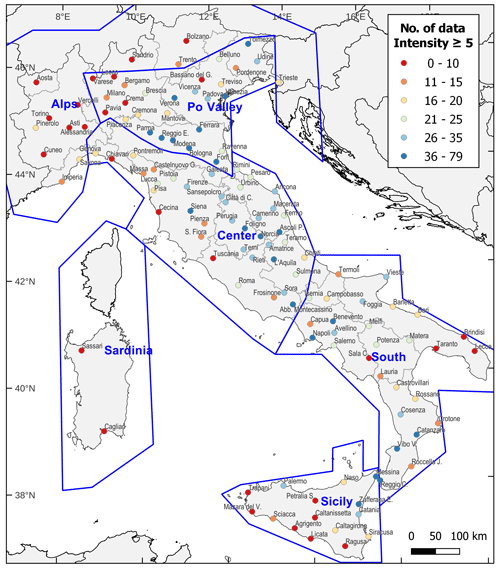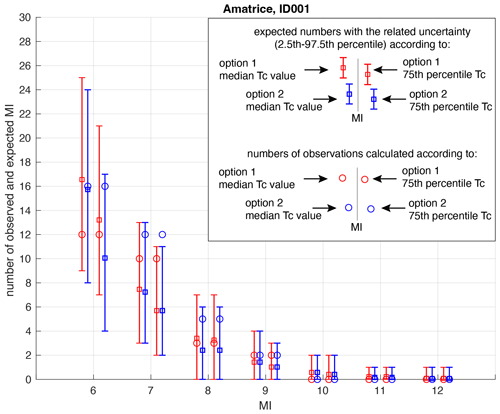the Creative Commons Attribution 4.0 License.
the Creative Commons Attribution 4.0 License.
Scoring and ranking probabilistic seismic hazard models: an application based on macroseismic intensity data
Francesco Visini
Andrea Rovida
Warner Marzocchi
Carlo Meletti
A probabilistic seismic hazard model consists of a set of weighted models/branches that describes the center, the body and the range of seismic hazard. Owing to the intrinsic nature of this kind of analysis, the weight of each model/branch represents its scientific credibility. However, practical uses of this model may sometimes require the selection of one or a few hazard curves that are sampled from the whole model, which often consists of thousands of branches. Here we put forward an innovative procedure that facilitates the scoring, ranking and selection of the hazard curves to account for the requirements of a specific application. The approach consists of a careful quality check of the data used for scoring and the adoption of a proper scoring rule. To show the applicability of this approach, we present an example that consists of scoring and ranking a set of multiple models/branches constituting a recent seismic hazard model of Italy. To score these branches, hazard estimates produced by each of them are compared with time series of macroseismic observations available in the Italian macroseismic database for a carefully selected set of localities deemed sufficiently representative, homogeneously distributed in space and complete with respect to time and intensity levels. The proper scoring parameter used for such a comparison is the logarithmic score, which can always be applied independently of the distribution of the data.
- Article
(3994 KB) - Full-text XML
-
Supplement
(2601 KB) - BibTeX
- EndNote
Probabilistic seismic hazard analysis (PSHA) provides basic information for the proper application of the building code. Owing to the important practical implications, PSHA models have to be widely accepted by a large scientific community. This acceptance is usually achieved by using commonly adopted procedures to calculate PSHA, and the full description of associated uncertainties is one of the key points in reliable models (Gerstenberger et al., 2020).
PSHA is usually built considering different models or branches of a logic tree, which mimics the so-called epistemic uncertainty, i.e., our ignorance of the true seismic hazard value. A critical aspect in quantitatively describing the distribution of the epistemic uncertainty is the way in which the weight of each model or branch is assigned.
Conceptually, the weighting of each model can follow two main general procedures (e.g., Albarello and D'Amico, 2015): the first one is ex ante, which considers inherent properties of each competing PSHA model, i.e., its ability to take into account the current knowledge of the underlying physical process evaluated by panels of experts; the second one is ex post, which empirically scores a set of alternative models by comparing the forecasting performance of their outcomes with available seismic observations. The first approach was the most commonly adopted in the past (e.g., Stucchi et al., 2011; Woessner et al., 2015), whereas today, thanks to the large availability of seismic data for comparisons, state-of-the-art PSHA models tend to adopt a combination of the two approaches (e.g., Danciu et al., 2021; Petersen et al., 2024). For example, in the recent PSHA model for Italy called MPS19 (Meletti et al., 2021), the weight of each branch was assigned according to both ways, which entails testing the performance of its components, i.e., seismicity and ground motion attenuation models, against available observations and evaluating the models by a panel of experts. Worthy of note, independently of the specific scheme adopted, the weighting of each PSHA model relies on available scientific knowledge.
The use of a PSHA model for practical applications may need additional evaluations. In fact, most practical applications require the choice of one or a few hazard curves that are sampled from the model. For instance, many current building codes arbitrarily use the mean hazard, neglecting de facto the dispersion of all other hazard curves. Here we propose an innovative post-processing scoring strategy that facilitates the ranking and sampling of models/branches of a PSHA model to consider specific requests from stakeholders, e.g., those responsible for planning seismic risk reduction strategies.
We introduce the procedure through an application to score and rank a set of multiple models/branches that constitute the MPS19 seismic hazard model of Italy according to their fit with macroseismic intensity data available in a large set of selected sites; the aim is selecting the models/branches that minimize the difference between PSHA outcomes and macroseismic observations at these sites. The scoring procedure consists of a careful quality check of the data used for scoring and the adoption of a proper scoring rule.
MPS19 consists of 11 groups of seismicity models (each composed by a set of sub-models, for a total of 94 seismicity models) combined with three ground motion models (GMMs) for the active shallow crustal areas (Bindi et al., 2011, 2014; Cauzzi et al., 2015), with two GMMs for the subduction zone of the Calabrian Arc (Skarlatoudis et al., 2013; Abrahamson et al., 2016) and one for the volcanic areas (Lanzano and Luzi, 2020), producing a total of 564 branches. The hazard was computed in terms of peak ground acceleration (PGA) and spectral acceleration (SA) in the 0.05–4 s period range, for return periods from 30 to 5000 years (for more details on MPS19, see Visini et al., 2021, for seismicity models; Lanzano et al., 2020, for GMMs; and Meletti et al., 2021, for the whole model).
Specifically, the scoring procedure proposed here consists of comparing the hazard of each branch of MPS19 with the time series of macroseismic observations (“seismic histories”) available in the Italian macroseismic database DBMI15 v1.5 (Locati et al., 2016; https://emidius.mi.ingv.it/CPTI15-DBMI15_v1.5/query_place/, last access: 19 April 2024) for a set of localities deemed sufficiently complete.
The proper scoring parameter for such a comparison is the logarithmic score (Gneiting and Raftery, 2007), which can always be applied independently of the specific distribution of the data; when the data follow a Poisson distribution, the logarithmic score is also named the log-likelihood score (LL):
where pi is the probability that each model attributes to the ith observation above the N available. Gneiting and Raftery (2007) show that many other metrics, such as probability, do not have these characteristics and should not be used.
The main phases of the proposed procedure are the following: (i) identification of the testing localities where hazard estimates of the individual models are compared with available seismic histories, (ii) building of the datasets of the observed and expected macroseismic intensities for each locality, (iii) comparison between estimates from each branch and the observed data in terms of LL of the differences between the number of macroseismic data predicted by the model and the number of those observed for different intensity degrees, and (iv) scoring and ranking of the models.
Although our application is focused on a specific PSHA model, we emphasize the generalizability to any other model and kind of observation (e.g., accelerometric data, fragile geological structures), provided they are treated with ad hoc procedures.
The first step of our procedure is the identification of the set of localities for evaluating the consistency of PSHA models with available observations; then, for each site, two datasets of macroseismic intensities, one of observed data and one of intensities expected according to the hazard estimates, have to be built.
2.1 Selection of the testing localities
The selection of the sites where PSHA models' outputs are compared with available observations represents one of the most crucial issues of the scoring procedure and thus needs great attention.
In order to have a representative set of sites to perform tests, the selected localities have to guarantee the following: (i) a geographical coverage as dense and uniform as possible throughout the whole investigated area, in relation to both high- and low-hazard regions, and (ii) seismic histories with a significant number of data, spanning long time periods and covering a wide range of intensity values (see the examples in Fig. 1).
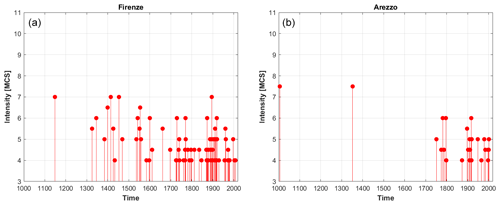
Figure 1Examples of seismic histories of two nearby Italian provincial capitals. The seismic history of Florence (Firenze, in Italian) (a) is extended and regular in time (for intensities larger than 4 on the Mercalli–Cancani–Sieberg (MCS) scale; Sieberg, 1923), whereas the one of Arezzo (b) shows significant gaps in time (i.e., during the 1350–1750 and 1800–1850 periods).
In the application to the Italian territory described here, we first identify 133 sites corresponding to 97 provincial capitals and 36 localities selected in an attempt to fulfill the above criteria.
We further check the representativeness of their seismic histories, provided by DBMI15 v1.5, comparing the seismic hazard estimates computed at each locality by means of the so-called “site” approach to PSHA (SASHA; D'Amico and Albarello, 2008) using (i) only the observed intensity data in DBMI15 and (ii) the observed data integrated with “virtual” intensities calculated from earthquake parameters of the CPTI15 v1.5 catalogue (Rovida et al., 2016) through an intensity attenuation relationship (Pasolini et al., 2008, recalibrated by Lolli et al., 2019). Large differences between the two resulting hazard estimates may indicate localities with “poor” seismic histories and/or with evident lack of data that should not be used for scoring.
On the basis of this analysis, which leads to the elimination or replacement of 13 localities that might bias the tests (six sites are retained to avoid large uncovered areas, although they have poor seismic histories), and the re-examination of the geographical distribution of the resulting sites, a further analysis is carried out to thin out very dense areas in northern and central Italy and to increase the density in some areas in the south. The final set of 124 locations selected for scoring is shown in Fig. 2.
2.2 Completeness periods of site seismic histories
In DBMI15, 9308 intensity data are referred to the selected localities and are associated with 2400 earthquakes spanning the 1000–2014 period and the whole range of intensity degrees, up to 10–11 on the Mercalli–Cancani–Sieberg (MCS) scale (Sieberg, 1923).
However, the consistency check of the hazard estimates provided by a given model with the macroseismic observations available at the selected localities requires that the number of intensities expected from the model at each site is compared with a complete set of observed intensities for each intensity degree. As a consequence, to calculate the number of macroseismic data at each site, both observed and expected, it is first necessary to estimate the completeness time intervals for each intensity degree, i.e., the periods in which it is reasonable to assume that all the earthquake effects above a given intensity have actually been reported in the seismic history (see Stucchi et al., 2004; Antonucci et al., 2023). For this reason, the completeness of the site seismic histories is different from the completeness of the earthquake catalogue. Indeed, the effects of an earthquake that occurred in the complete period of the catalogue might not be recorded at a given site for several reasons (e.g., they were not documented or documentation exists but has not been analyzed).
In our case study, the completeness time intervals for each site are defined using the statistical approach of Albarello et al. (2001) applied to observed data with an intensity greater than or equal to 5 MCS according to the following procedure:
-
intensity data related to earthquakes in CPTI15 identified as “mainshocks”, according to the declustering method used in MPS19 (Gardner and Knopoff, 1974), are considered;
-
only intensity data of earthquakes up to 2006 are used because after that year the systematic collection of macroseismic data ceased, and DBMI15 is incomplete (Antonucci, 2022);
-
intensities expressed in DBMI15 as non-numerical values, e.g., F for “felt” and HD for “heavy damage” (see Rovida et al., 2020, for their complete list), are discarded;
-
uncertain intensities between adjacent integer degrees (e.g., 6–7 MCS) are treated as either the lowest degree (option 1) or the highest one (option 2).
For each macroseismic intensity (MI) threshold, two completeness estimates are therefore obtained, in terms of the starting year of the complete period (Tc), with respect to the two options for assigning the uncertain degrees described above. To take the uncertainty in the estimation of completeness into account, the two Tc values corresponding to the median and the 75th percentile of the completeness function provided by the adopted method are considered for a total of four Tc values. The estimates of Tc corresponding to the 25th percentile of the completeness function are not taken into account as they are considered unrealistic, especially for high degrees (see the example in Fig. 3). Finally, in the case that the completeness period of a given intensity threshold is shorter than that of the lower one (e.g., for 9 MCS in Fig. 3b), the latter period is considered for both the thresholds.
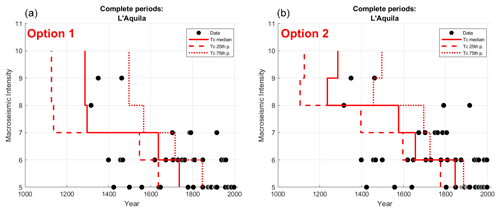
Figure 3Example of the completeness graph for the city of L'Aquila according to the two options for assigning uncertain degrees. (a) Uncertain degrees are assigned to the lowest degree (option 1) and (b) to the highest degree (option 2). The red bars indicate, for each MI threshold, the three estimates of the completeness starting year Tc (the median value is denoted with the solid line, and the 25th and 75th percentiles are denoted with the dashed lines). The black dots correspond to intensities observed up to 2006, extracted from DBMI15.
2.3 Dataset of observed intensities
According to the procedures described above, the dataset of observed macroseismic intensities for each testing locality is built counting, for each MI degree, the number of data after the two different completeness starting years, Tc, i.e., those corresponding to the median value and the 75th percentile of the completeness function, considering both options 1 and 2 for treating the uncertain degrees.
Thus, four estimates of the number of observed data for each intensity degree are obtained, corresponding to the following:
- i.
option 1 and the median Tc value (2100 data)
- ii.
option 1 and the 75th percentile Tc value (1671 data)
- iii.
option 2 and the median Tc value (2557 data)
- iv.
option 2 and the 75th percentile Tc value (2076 data).
In parentheses, the total number of data for all intensity degrees and selected localities is reported.
The resulting number of data is finally cumulated to obtain the observed exceedances for each considered MI degree at each locality.
2.4 Dataset of expected intensities
The number of expected intensity data at each site on the basis of the hazard estimates provided by the individual branches of MPS19 is computed as follows:
-
The hazard curve for each branch is calculated assuming a value of VS,30 equal to 600 m s−1, that is for EC8 soil category B instead of A ( m s−1) to which the MPS19 model refers. This is because macroseismic intensity values quantify the earthquake effects (in particular the levels of building damage) observed in extended localities that, in Italy, are generally located on class B soils ( m s−1; see, e.g., Mori et al., 2020) rather than on rocky soils.
-
From each hazard curve, expressed as the annual rates of exceedance of different levels of shaking in terms of PGA or SA, the corresponding annual rates of occurrence are obtained. These are then converted into occurrence rates of different degrees of intensity λ(MI) through the ground motion intensity conversion equation (GMICE) by Gomez Capera et al. (2020), taking into account the associated uncertainties, as follows:
where λ(xj) is the annual occurrence rate of each of the M levels of PGA (or SA) in the hazard curve, and P(MI|xj) corresponds to the conditional probability distribution of the GMICE, as proposed by D'Amico and Albarello (2008).
-
The rates of occurrence in intensity estimated in this way are then multiplied by the lengths of the corresponding completeness periods to obtain the number of macroseismic data expected for each intensity degree. As done for the observed intensity data, the four estimates of the completeness periods are considered (starting from the median Tc value and the 75th percentile of the completeness function and for the two options for assigning the uncertain degrees).
-
The resulting number of data is finally cumulated to obtain the expected exceedances for each MI degree.
Figure 4 shows an example of the comparison between the number of observed and expected macroseismic data in the locality of Amatrice for different intensity thresholds.
The parameter used for evaluating the consistency of the predictions of a given PSHA model with the macroseismic observations available for the testing localities is the log-likelihood (LL) score (Eq. 1). In this application, comparisons between forecasts and observations are made for individual branches (or models) of MPS19 starting from the hazard curves calculated at each testing site for soil class B ( m s−1) for PGA, SA 0.2 and SA 1 s, which are considered to be the most relevant spectral periods for engineering purposes. The total number of analyzed branches is 282 out of the 564 of MPS19 because the hazard values estimated at the testing sites using the two alternative GMMs selected for the subduction zone are almost identical, and only the branches adopting the model of Skarlatoudis et al. (2013), which obtained the highest weight, are considered.
3.1 Calculation of the log-likelihood (LL) score
As described in the previous section, for each considered testing locality and for each PSHA branch, four pairs of observed and expected numbers of intensity data are obtained for each MI threshold, corresponding to the four different estimates of the completeness periods, i.e., for the median value and the 75th percentile of the completeness function and the two options for treating uncertain intensity degrees (see the example in Fig. 4).
For each site and branch, for each MI threshold, and for each of the four pairs of observed and expected numbers of intensity data, the probability p of the tails of the Poisson distribution is calculated through the following algorithm (Zechar et al., 2010).
If the number of observed data (Nobs) is greater than the number of expected ones (Nexp),
if the number of observed data is lower than or equal to the number of expected ones,
where F is the right-continuous Poisson cumulative distribution function with expectation Nexp evaluated at Nobs:
The two probabilities (p), defined in Eqs. (3) and (4), answer the following question: is the forecast too low (Eq. 3) or too high (Eq. 4) compared to the observations?
For each site, we then calculate the weighted average of the four logarithmic scores (LL in Eq. 1), considering the four pairs of observed and expected numbers of data for an intensity greater than or equal to 6 (MI6+) and 8 (MI8+) MCS. These intensity levels correspond to the threshold of slight and structural building damage, respectively. The weighted average of observed and expected data is calculated by equally weighting the two estimates obtained from the median value and the 75th percentile of the completeness function and attributing different weights to the two options for treating uncertain degrees as follows: (i) 0.75 to option 1 (i.e., uncertain degree assigned to the lower MI value) and (ii) 0.25 to option 2 (i.e., uncertain degree assigned to the higher MI value). This choice is consistent with the meaning of uncertain intensity assignments described in Grünthal (1998).
The LL value calculated in this way is defined as LLsite.
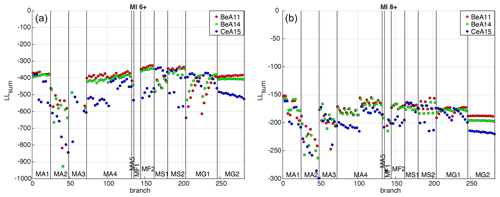
Figure 5Values of LLsum (sum of LLsite of all localities) calculated for each of the 282 considered branches of MPS19 for PGA, MI6+ (a) and MI8+ (b). The branches are represented in abscissa from left to right, grouped according to the 11 seismicity models (for the description of the models, see Meletti et al., 2021; Visini et al., 2021), and colored according to the three GMMs adopted for active crustal areas, namely BeA11 (Bindi et al., 2011), BeA14 (Bindi et al., 2014) and CeA15 (Cauzzi et al., 2015). Note that the y axis for MI6+ is truncated for the purpose of visualization, as a few values tend toward negative infinity.
3.2 Estimates of LL for each model
To identify the models that produce the hazard estimates that are most consistent with the macroseismic observations at the testing sites, we initially calculate, for each branch, the sum of the LLsite values relating to the 124 selected localities, defined as LLsum, for the three spectral periods (PGA, SA 0.2 and SA 1 s) and the two intensity thresholds (MI6+ and MI8+) considered. Figure 5 shows the LLsum values for PGA for all branches: the smaller (closer to 0) the value, the higher the consistency between the model's outcomes and the observations.
Then, to test the performance of each branch over different regions of the Italian territory, we group the selected localities according to the six macro-areas defined in MPS19 to estimate the completeness of the CPTI15 catalogue: Alps, Po Valley, Center, South, Sardinia and Sicily (see Fig. 2). Since these macro-areas include different numbers of sites, the average (instead of the sum) of the LLsite values is calculated for both the entire set of 124 localities and the localities in each macro-area (Sardinia is excluded since it has only two testing sites). Therefore, six LLmean values are obtained for each branch. Figure 6 shows the resulting LLmean values for PGA, for the two intensity thresholds MI6+ and MI8+ and for each adopted GMM.
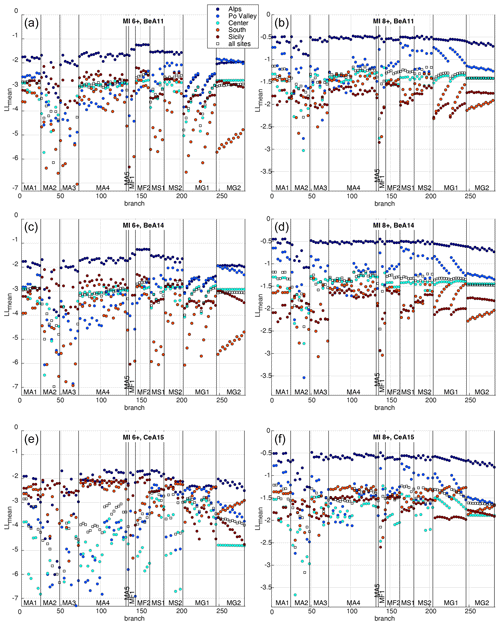
Figure 6Values of LLmean for each considered branch of MPS19 for the localities in five macro-areas and all the sites, for PGA, MI6+ (a, c, e), MI8+ (b, d, f), and each adopted GMM. The branches are represented in abscissa from left to right and are grouped according to the 11 seismicity models.
As shown, almost all the branches seem to give good agreement (i.e., LLmean values closer to 0) in the Alps macro-area, characterized by a much smaller number of sites. In the other four macro-areas, which are more significant in terms of the number of sites, the results appear to be very different depending on the different seismicity models. In particular, for the BeA11 and BeA14 GMMs, some groups of branches (e.g., MA2, MA3, MF1, MG1, MG2) show generally poorer performance in terms of LLmean values and a considerable geographical scatter, whereas others (e.g., MA1, MA4, MF2, MS2) show values of LLmean that are generally smaller and more stable in the four macro-areas. The plots of LLmean values for SA 0.2 and SA 1 s are reported in the Supplement (Figs. S1 and S2).
In order to evaluate the stability of the performance of each branch in the different areas, we then calculate the dispersion of the LLmean values among the four macro-areas including the highest number of localities (Po Valley, Center, South, Sicily) as the width of the interval between the 2.5th and 97.5th percentiles. The percentiles are estimated using a non-parametric distribution of the four LLmean values. Obviously, a different choice of the distribution might lead to changes in the percentiles, but the aim is only to give an order of magnitude of the dispersion among the measures in the macro-areas. Figure 7 shows the dispersion values computed for PGA for the two intensity thresholds considered (plots for SA 0.2 and SA 1 s are displayed in Fig. S3).
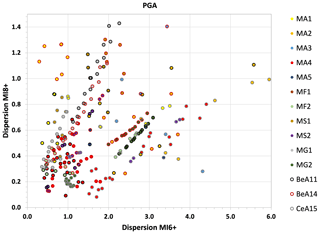
Figure 7Dispersion of the LLmean values among the four more representative macro-areas for each branch, for PGA, MI6+ and MI8+. The color of the dots indicates the seismicity model, while the color of the borders indicates the GMM used in that branch.
The LLmean values computed using the entire set of localities and the relative geographical dispersion are then used to establish a ranking of the branches.
3.3 Ranking of the models
Following the described procedure, a LLmean value for MI6+ and MI8+, for the three spectral periods (i.e., PGA, SA 0.2 and SA 1 s), is assigned to each of the 282 considered branches of MPS19, as well as an estimate of the dispersion of these values among the four more representative macro-areas.
For each spectral period and MI threshold, the branches are then ranked according to the values of LLmean and the relative geographical dispersion, assigning the first place to the branch with the “best” result (LLmean value or dispersion closest to 0) and the 282nd place to the “worst” one.
Initially, comparison plots of the ranks based on LLmean values for the two MI thresholds are produced, focusing the attention on the branches that fall within the 10th percentile. This choice, however subjective, is too restrictive, since none of the branches fall within this range for all the considered spectral periods. It is then decided to expand the selection criterion. Taking into account the first 70 positions (corresponding to the first quartile) in the LLmean tests, for both intensity thresholds and for the three spectral periods, we select 35 branches for PGA and 37 branches for SA 0.2 and SA 1 s, representing all the GMMs used and different seismicity models of MPS19.
Figure 8 shows the placement of each branch in the LLmean test for PGA; the plots for SA 0.2 and SA 1 s are reported in the Supplement (Fig. S4). In all the plots, the best ranks are generally occupied by the same models, for both MI thresholds.
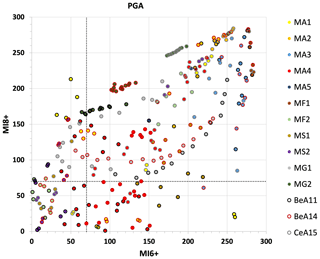
Figure 8Comparison between the ranking of the branches for PGA, based on the LLmean values for MI6+ and MI8+. The color of the dots indicates the seismicity model, while the color of the borders indicates the GMM used in that branch. The dotted black lines identify the 70th position in both rankings.
The geographical dispersion of LLmean values among the four more representative macro-areas is then considered. For each spectral period, a ranking of the branches is made according to this parameter as well, and the ranks are grouped into three classes, for both MI6+ and MI8+, as follows: (i) rank ≤ 100, (ii) rank 101–150 and (iii) rank > 150.
An overall rank (from 1, best rank, to 5) is then assigned to each selected branch, for each of the three spectral periods, based on the ranking class for the two intensity thresholds (see the abacus in Table 1).
Table 1Abacus built to assign an overall rank to each selected branch, for each spectral period considered, on the basis of its rank resulting from the dispersion of LLmean values in the four macro-areas.
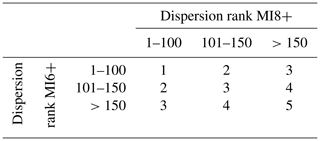
Table 2Overall ranks of the 20 best-performing selected branches, according to the abacus in Table 1. The following columns report the position in every computed rank; the cells with bold numbers mark the branches falling in the first 70 positions in the LLmean ranking.
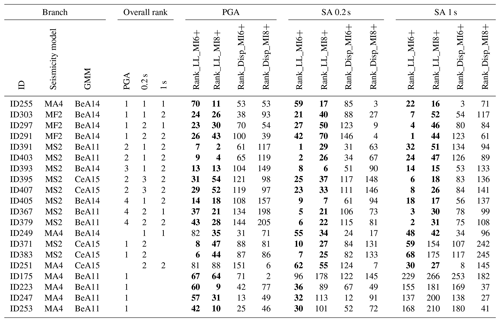
The overall rank could allow practitioners to further sample and/or (re-)weight the various branches according to the practical constraints of a specific application. Table 2 shows the overall ranks for the 20 best-performing selected branches for PGA, SA 0.2 and SA 1 s. As an example, if one decides to consider the models with an overall rank equal to 1 or 2 for all the spectral periods, only the first six should be selected.
We have introduced a new scoring strategy that may be used to rank and sample the multiple models/branches of a PSHA model. Scoring is inherently different from testing: the former term indicates approaches devoted to ranking and eventually weighting a set of competing models, whereas testing procedures aim at evaluating the absolute predictive accuracy of each model, indicating if its outcomes are or are not compatible with observations to a given significance level threshold. Therefore, testing can allow us to identify possibly wrong PSHA models, whereas scoring is aimed at comparing models according to a specific metric of interest.
For the sake of giving an example, we have scored and ranked alternative branches of the MPS19 seismic hazard model of Italy (Meletti et al., 2021) according to their fit with long-term macroseismic intensity data available in a large set of sites, with the scope of selecting the models/branches that minimize the difference between PSHA outcomes and macroseismic observations at these sites. To properly compare the performance of the different branches, a log-likelihood score has been assigned to each of them based on the comparison between numbers of expected and observed intensity data at each site for different shaking levels and spectral periods, not considering single return periods but the entire hazard curve.
In countries such as Italy, where the historical record is hundreds of years long, i.e., much longer than the instrumental one, and macroseismic information covers the whole territory (Locati et al., 2022), the use of macroseismic intensity observations for scoring PSHA models could be more suitable than accelerometric recordings for considering the effects of earthquakes with large magnitudes and long return periods.
Of course, comparing PSHA outcomes in terms of PGA or SA with macroseismic data requires caution due to the use of GMICEs, which are empirical conversion relationships characterized by large uncertainties to be taken into account. In fact, if one simply converts the ground motion value (e.g., PGA) resulting from a PSHA model into macroseismic intensity just using the average estimates and discarding associated variance, the comparison could be severely biased. In the scoring procedure presented here, this issue is solved through the convolution of the relevant probability distributions (i.e., hazard curves and GMICE), as proposed by D'Amico and Albarello (2008). Moreover, the procedure takes into account the peculiar nature of intensity values (discrete, ordinal, range-limited) and associated uncertainties (uncertain intensity values between adjacent integer degrees, completeness of site seismic history, etc.).
A further crucial issue related to using macroseismic intensity data for empirical scoring concerns the selection of sites where PSHA models' outputs can be compared with available observations. In fact, to have a representative set of localities to perform tests, selected sites have to guarantee a geographical coverage as dense and uniform as possible throughout the study area (for both high- and low-hazard regions) as well as a significant number of macroseismic data at each site, covering long time periods and a wide range of intensity values. This clearly limits the use of macroseismic data as observables to countries with long records of documentary information about the effects of past earthquakes at a sufficient number of sites (e.g., Fäh et al., 2011, for Switzerland; BRGM-EDF-IRSN/SisFrance, 2017, for France).
The presented procedure can be applied to any kind of model and set of observational data, for instance to rank and select branches of a complex PSHA model to get one outcome that better satisfies specific stakeholders' needs. In this regard, it is important to remark that our approach is based on a rigorous and quantitative procedure, although the definition of the thresholds and ranks for selecting branches is a subjective choice that depends on specific considerations and aims.
CPTI15 v1.5 is available at https://doi.org/10.6092/ingv.it-cpti15 (Rovida et al., 2016), and DBMI15 v1.5 is available at https://doi.org/10.6092/ingv.it-dbmi15 (Locati et al., 2016).
The supplement related to this article is available online at: https://doi.org/10.5194/nhess-24-1401-2024-supplement.
All authors designed the scoring strategy and prepared the paper. VDA wrote the draft of the paper and contributed to the selection of the testing sites, the estimation of the expected intensities and the ranking of the models. FV computed the completeness periods, the number of observed and expected intensity data, and the LL values. AR performed the selection of the testing sites and contributed to the estimation of the completeness periods. WM proposed the scoring rule, and CM performed the ranking of the models.
The contact author has declared that none of the authors has any competing interests.
Publisher's note: Copernicus Publications remains neutral with regard to jurisdictional claims made in the text, published maps, institutional affiliations, or any other geographical representation in this paper. While Copernicus Publications makes every effort to include appropriate place names, the final responsibility lies with the authors.
This article is part of the special issue “Harmonized seismic hazard and risk assessment for Europe”. It is not associated with a conference.
The authors wish to thank Dario Albarello and the anonymous referee for their useful comments and suggestions. Thanks are also due to Andrea Antonucci and Matteo Taroni for their support in the selection of the testing sites and in the computation of the LL values, respectively.
This research has been supported by the Italian Presidenza del Consiglio dei Ministri – Dipartimento della Protezione Civile (DPC), under the framework of the DPC-INGV agreement B1 (2020–2021), and by the Seismic Hazard Center (Centro di Pericolosità Sismica, CPS) of the Istituto Nazionale di Geofisica e Vulcanologia (INGV). This paper does not represent the DPC's official opinion and policies.
This paper was edited by Laurentiu Danciu and reviewed by Dario Albarello and one anonymous referee.
Abrahamson, N., Gregor, N., and Addo, K.: BC Hydro ground motion prediction equations for subduction earthquakes, Earthq. Spectra, 32, 23–44, https://doi.org/10.1193/051712EQS188MR, 2016.
Albarello, D. and D'Amico, V.: Scoring and testing procedures devoted to probabilistic seismic hazard assessment, Surv. Geophys., 36, 269–293, https://doi.org/10.1007/s10712-015-9316-4, 2015.
Albarello, D., Camassi, R., and Rebez, A.: Detection of space and time heterogeneity in the completeness of a seismic catalog by a statistical approach: an application to the Italian area, Bull. Seismol. Soc. Am., 91, 1694–1703, https://doi.org/10.1785/0120000058, 2001.
Antonucci, A.: A probabilistic approach for integrating macroseismic data and its application to estimate the data completeness, PhD Thesis, University of Pisa, Pisa, 222 pp. https://etd.adm.unipi.it/theses/available/etd-02222022-104750/unrestricted/Andrea_Antonucci_PhD_Thesis.pdf (last access: 19 April 2024), 2022.
Antonucci, A., Rovida, A., D'Amico, V., and Albarello, D.: Looking for undocumented earthquake effects: a probabilistic analysis of Italian macroseismic data, Nat. Hazards Earth Syst. Sci., 23, 1805–1816, https://doi.org/10.5194/nhess-23-1805-2023, 2023.
Bindi, D., Pacor, F., Luzi, L., Puglia, R., Massa, M., Ameri, G., and Paolucci, R.: Ground motion prediction equations derived from the Italian strong motion database, Bull. Earthq. Eng., 9, 1899–1920, https://doi.org/10.1007/s10518-011-9313-z, 2011.
Bindi, D., Massa, M., Luzi, L., Ameri, G., Pacor, F., Puglia, R., and Augliera, P.: Pan-European ground-motion prediction equations for the average horizontal component of PGA, PGV, and 5 %-damped PSA at spectral periods up to 3.0 s using the RESORCE dataset, Bull. Earthq. Eng., 12, 391–430, https://doi.org/10.1007/s10518-013-9525-5, 2014.
BRGM-EDF-IRSN/SisFrance: Histoire et caractéristiques des séismes ressentis en France, http://www.sisfrance.net (last access: 19 April 2024), 2017.
Cauzzi, C., Faccioli, E., Vanini, M., and Bianchini, A.: Updated predictive equations for broadband (0.01–10 s) horizontal response spectra and peak ground motions, based on a global dataset of digital acceleration records, Bull. Earthq. Eng., 13, 1587–1612, https://doi.org/10.1007/s10518-014-9685-y, 2015.
D'Amico, V. and Albarello, D.: SASHA: a computer program to assess seismic hazard from intensity data, Seismol. Res. Lett., 79, 663–671, https://doi.org/10.1785/gssrl.79.5.663, 2008.
Danciu, L., Nandan, S., Reyes, C., Basili, R., Weatherill, G., Beauval, C., Rovida, A., Vilanova, S., Sesetyan, K., Bard, P.-Y., Cotton, F., Wiemer, S., and Giardini, D.: The 2020 update of the European Seismic Hazard Model: Model Overview, EFEHR Technical Report 001, v1.0.0, https://doi.org/10.12686/a15, 2021.
Fäh, D., Giardini, D., Kästli, P., Deichmann, N., Gisler, M., Schwarz-Zanetti, G., Alvarez-Rubio, S., Sellami, S., Edwards, B., Allmann, B., Bethmann, F., Wössner, J., Gassner-Stamm, G., Fritsche, S., and Eberhard, D.: ECOS-09 Earthquake Catalogue of Switzerland Release 2011 Report and Database, Public catalogue, 17.4.2011, Swiss Seismological Service ETH Zurich, Report SED/RISK/R/001/20110417, 42 pp. + Appendixes, ETH Zurich, http://www.seismo.ethz.ch/static/ecos-09/ECOS-2009_Report_final_WEB.pdf (last access: 19 April 2024), 2011.
Gardner, J. K. and Knopoff, L.: Is the sequence of earthquakes in Southern California, with aftershocks removed, Poissonian?, Bull. Seismol. Soc. Am., 64, 1363–1367, 1974.
Gerstenberger, M. C., Marzocchi, W., Allen, T., Pagani, M., Adams, J., Danciu, L., Field, E. H., Fujiwara, H., Luco, N., Ma, K.-F., Meletti, C., and Petersen, M. D.: Probabilistic seismic hazard analysis at regional and national scale: state of the art and future challenges, Rev. Geophys., 58, e2019RG000653, https://doi.org/10.1029/2019RG000653, 2020.
Gneiting, T. and Raftery, A. E.: Strictly proper scoring rules, prediction, and estimation, J. Am. Stat. Assoc., 102, 359–378, https://doi.org/10.1198/016214506000001437, 2007.
Gomez Capera, A. A., D'Amico, M., Lanzano, G., Locati, M., and Santulin, M.: Relationships between ground motion parameters and macroseismic intensity for Italy, Bull. Earthq. Eng., 18, 5143–5164, https://doi.org/10.1007/s10518-020-00905-0, 2020.
Grünthal, G.: European Macroseismic Scale 1998 (EMS-98), Cahiers du Centre Européen de Géodynamique et de Séismologie, 99 pp., https://media.gfz-potsdam.de/gfz/sec26/resources/documents/PDF/EMS-98_Original_englisch.pdf (last access: 19 April 2024), 1998.
Lanzano, G. and Luzi, L.: A ground motion model for volcanic areas in Italy, Bull. Earthq. Eng., 18, 57–76, https://doi.org/10.1007/s10518-019-00735-9, 2020.
Lanzano, G., Luzi, L., D'Amico, V., Pacor, F., Meletti, C., Marzocchi, W., Rotondi, R., and Varini, E.: Ground motion models for the new seismic hazard model of Italy (MPS19): selection for active shallow crustal regions and subduction zones, Bull. Earthq. Eng., 18, 3487–3516, https://doi.org/10.1007/s10518-020-00850-y, 2020.
Locati, M., Camassi, R., Rovida, A., Ercolani, E., Bernardini, F., Castelli, V., Caracciolo, C. H., Tertulliani, A., Rossi, A., Azzaro, R., D'Amico, S., Conte, S., and Rocchetti, E.: Italian Macroseismic Database (DBMI15), version 1.5, INGV – Istituto Nazionale di Geofisica e Vulcanologia [data set], https://doi.org/10.6092/INGV.IT-DBMI15, 2016.
Locati, M., Camassi, R., Rovida, A., Ercolani, E., Bernardini, F., Castelli, V., Caracciolo, C. H., Tertulliani, A., Rossi, A., Azzaro, R., D'Amico, S., and Antonucci, A.: Italian Macroseismic Database (DBMI15), version 4.0, INGV – Istituto Nazionale di Geofisica e Vulcanologia [data set], https://doi.org/10.13127/DBMI/DBMI15.4, 2022.
Lolli, B., Pasolini, C., Gasperini, P., and Vannucci, G.: Product 4.8: Recalibration of the prediction equation by Pasolini et al. (2008), in: The seismic hazard model MPS19, Final report, edited by: Meletti, C. and Marzocchi, W., CPS-INGV, Rome, 168 pp. + 2 Appendixes, 2019.
Meletti, C., Marzocchi, W., D'Amico, V., Lanzano, G., Luzi, L., Martinelli, F., Pace, B., Rovida, A., Taroni, M., Visini, F., and the MPS19 Working Group: The new Italian seismic hazard model (MPS19), Ann. Geophys.-Italy, 64, SE112, https://doi.org/10.4401/ag-8579, 2021.
Mori, F., Mendicelli, A., Moscatelli, M., Romagnoli, G., Peronace, E., and Naso, G.: A new Vs30 map for Italy based on the seismic microzonation dataset, Eng. Geol., 275, 105745, https://doi.org/10.1016/j.enggeo.2020.105745, 2020.
Pasolini, C., Albarello, D., Gasperini, P., D'Amico, V., and Lolli, B.: The attenuation of seismic intensity in Italy, Part II: modeling and validation, Bull. Seismol. Soc. Am., 98, 692–708, https://doi.org/10.1785/0120070021, 2008.
Petersen, M. D., Shumway, A. M., Powers, P. M., Field, E. H., Moschetti, M. P., Jaiswal, K. S., Milner, K. R., Rezaeian, S., Frankel, A. D., Llenos, A. L., Michael, A. J., Altekruse, J. M., Ahdi, S. K., Withers, K. B., Mueller, C. S., Zeng, Y., Chase, R. E., Salditch, L. M., Luco, N., Rukstales, K. S., Herrick, J. A., Girot, D. L., Aagaard, B. T., Bender, A. M., Blanpied, M. L., Briggs, R. W., Boyd, O. S., Clayton, B. S., DuRoss, C. B., Evans, E. L., Haeussler, P. J., Hatem, A. E., Haynie, K. L., Hearn, E. H., Johnson, K. M., Kortum, Z. A., Kwong, N. S., Makdisi, A. J., Mason, H. B., McNamara, D. E., McPhillips, D. F., Okubo, P. G., Page, M. T., Pollitz, F. F., Rubinstein, J. L., Shaw, B. E., Shen, Z.-K., Shiro, B. R., Smith, J. A., Stephenson, W. J., Thompson, E. M., Thompson Jobe, J. A., Wirth, E. A., and Witter, R. C.: The 2023 US 50-State National Seismic Hazard Model: Overview and implications, Earthq. Spectra, 40, 5–88, https://doi.org/10.1177/87552930231215428, 2024.
Rovida, A., Locati, M., Camassi, R., Lolli, B., and Gasperini, P.: Italian Parametric Earthquake Catalogue (CPTI15), version 1.5, INGV – Istituto Nazionale di Geofisica e Vulcanologia [data set], https://doi.org/10.6092/ingv.it-cpti15, 2016.
Rovida, A., Locati, M., Camassi, R., Lolli, B., and Gasperini, P.: The Italian earthquake catalogue CPTI15, Bull. Earthq. Eng., 18, 2953–2984, https://doi.org/10.1007/s10518-020-00818-y, 2020.
Sieberg, A.: Geologische, physikalische und angewandte Erdbebenkunde, G. Fischer, Jena, 1923.
Skarlatoudis, A. A., Papazachos, C. B., Margaris, B. N., Ventouzi, C., Kalogeras, I., and the EGELADOS Group: Ground-Motion Prediction Equations of intermediate-depth earthquakes in the Hellenic Arc, Southern Aegean subduction area, Bull. Seismol. Soc. Am., 103, 1952–1968, https://doi.org/10.1785/0120120265, 2013.
Stucchi, M., Albini, P., Mirto, M., and Rebez, A.: Assessing the completeness of Italian historical earthquake data, Ann. Geophys.-Italy, 47, 2–3, https://doi.org/10.4401/ag-3330, 2004.
Stucchi, M., Meletti, C., Montaldo, V., Crowley, H., Calvi, G. M., and Boschi, E.: Seismic hazard assessment (2003–2009) for the Italian building code, Bull. Seismol. Soc. Am., 101, 1885–1911, https://doi.org/10.1785/0120100130, 2011.
Visini, F., Pace, B., Meletti, C., Marzocchi, W., Akinci, A., Azzaro, R., Barani, S., Barberi, G., Barreca, G., Basili, R., Bird, P., Bonini, M., Burrato, P., Busetti, M., Carafa, M. M. C., Cocina, O., Console, R., Corti, G., D'Agostino, N., D'Amico, S., D'Amico, V., Dal Cin, M., Falcone, G., Fracassi, U., Gee, R., Kastelic, V., Lai, C. G., Langer, H., Maesano, F. E., Marchesini, A., Martelli, L., Monaco, C., Murru, M., Peruzza, L., Poli, M. E., Pondrelli, S., Rebez, A., Rotondi, R., Rovida, A., Sani, F., Santulin, M., Scafidi, D., Selva, J., Slejko, D., Spallarossa, D., Tamaro, A., Tarabusi, G., Taroni, M., Tiberti, M. M., Tusa, G., Tuvè, T., Valensise, G., Vannoli, P., Varini, E., Zanferrari, A., and Zuccolo, E.: Earthquake rupture forecasts for the MPS19 seismic hazard model of Italy, Ann. Geophys.-Italy, 64, SE220, https://doi.org/10.4401/ag-8608, 2021.
Woessner, J., Danciu, L., Giardini, D., Crowley, H., Cotton, F., Grünthal, G., Valensise, G., Arvidsson, R., Basili, R., Demircioglu, M. B., Hiemer, S., Meletti, C., Musson, R., Rovida, A., Sesetyan, K., Stucchi, M., and the SHARE consortium: The 2013 European seismic hazard model: key components and results, Bull. Earthq. Eng., 13, 3553–3596, https://doi.org/10.1007/s10518-015-9795-1, 2015.
Zechar, J. D., Gerstenberger, M. C., and Rhoades, D.: Likelihood-based tests for evaluating space-rate-magnitude earthquake forecasts, Bull. Seismol. Soc. Am., 100, 1184–1195, https://doi.org/10.1785/0120090192, 2010.
- Abstract
- Introduction
- Building the datasets of observed and expected intensities
- Consistency test between hazard estimates and macroseismic observations
- Discussion and conclusions
- Data availability
- Author contributions
- Competing interests
- Disclaimer
- Special issue statement
- Acknowledgements
- Financial support
- Review statement
- References
- Supplement
- Abstract
- Introduction
- Building the datasets of observed and expected intensities
- Consistency test between hazard estimates and macroseismic observations
- Discussion and conclusions
- Data availability
- Author contributions
- Competing interests
- Disclaimer
- Special issue statement
- Acknowledgements
- Financial support
- Review statement
- References
- Supplement






